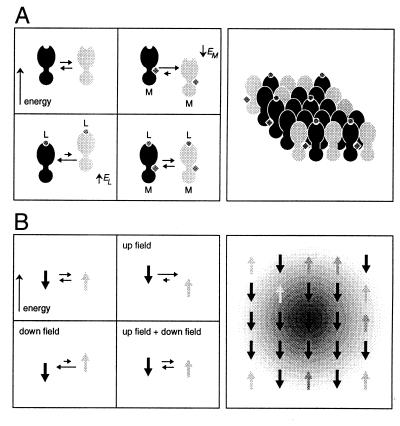Figure 1.
(A) Representation of the relative energies of the two conformational states of a receptor. The active (gray) and inactive (black) states of a virgin, isolated receptor have the same energy. Ligand binding (L) lowers the energy of the inactive state, and methylation (M) reduces the energy of the active state. When a receptor is part of a cluster, it also interacts with its four nearest neighbors; its energy is lowered by each adjacent receptor in the same conformational state and raised by each adjacent receptor in the alternative state. (B) This picture is analogous to the Ising model of a ferromagnet. An isolated magnetic spin is equally likely to point up (gray) or down (black). However, when a magnetic field is applied, the spin tends to point in the direction of the field (because it then has a lower energy). A ferromagnet is a lattice of coupled spins. In the Ising model, a cooperative interaction between adjacent spins lowers each of their energies when both spins have the same sign. Consequently, neighboring spins tend to align with one another. The magnetic properties of the array of spins depend on the magnitude of the coupling energy. Above a critical value, a high proportion of the spins all point in the same direction, and the array is ferromagnetic. Below the critical value, the array is paramagnetic (i.e., it is magnetized only when an external field is applied). Close to (but below) the critical point, the propagation of nearest-neighbor interactions causes one spin to influence other spins over a wide range (depicted by the shaded area). Then, a weak external field gives rise to a strong magnetization. In the receptor cluster, by analogy, a small change in the amount of bound ligand generates a big response.

